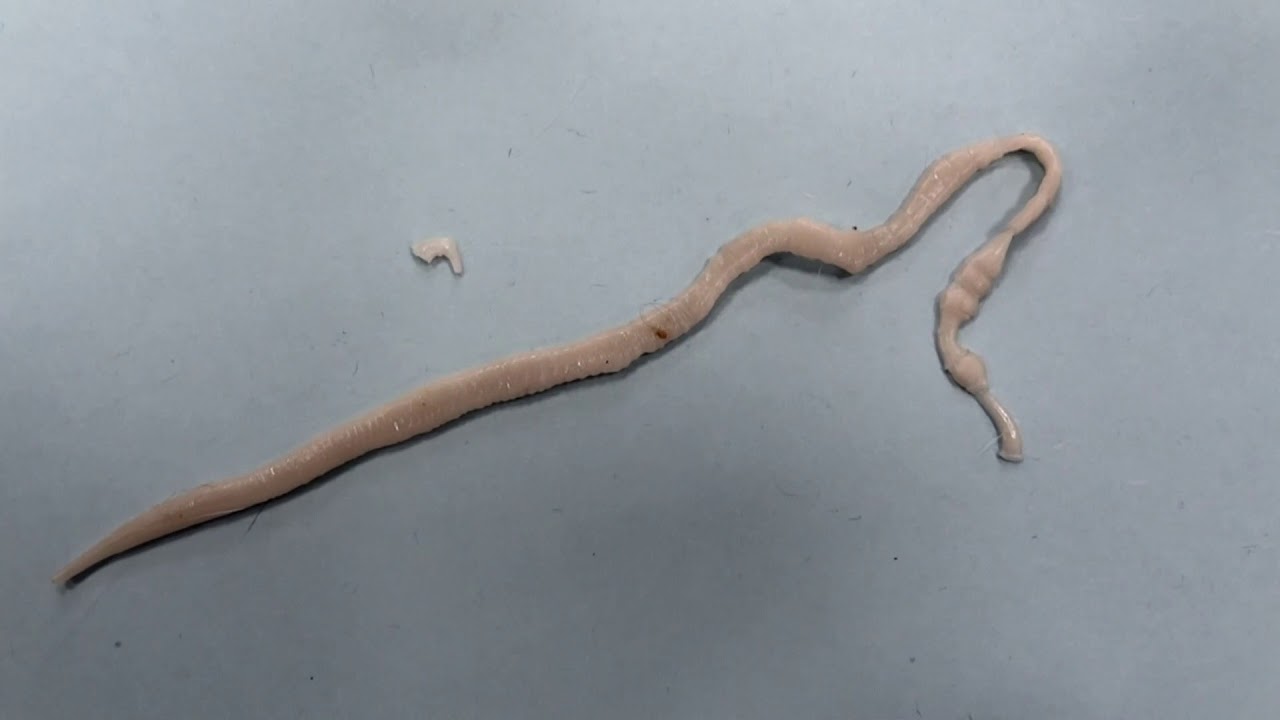Worms in dogs
Worms most often colonize the intestines of our four-legged friends, but they can also settle in other organs, such as the heart, the lungs or the surface of the eye.
The mere presence of worms in a dog's body can be problematic for its health, but the situation becomes more complicated when these parasites proliferate massively, causing internal lesions that can be irreversible.
To protect your pet from worms, prevention remains the most effective weapon offered by veterinary medicine. However, since preventive treatments are not 100% effective, it is also essential to recognize the signs of parasites in your dog in order to adopt the right attitude to remedy the situation.
What are they?
Dog worms are internal parasites, i.e. small animals that live at the expense of their host by settling inside the body. These parasites are sometimes well tolerated by their host, but they can also cause health problems and even threaten the life of the dog by causing internal lesions.
It is important to note that some of these parasites can be transmitted to humans, especially children, in which case they can cause very serious problems - much more serious than in our four-legged companions. There are a wide variety of different worms in dogs, some of which are significantly more prevalent than others, as presented in this article.
Digestive worms in dogs
The most common worms found in dogs are usually found in the digestive tract, more specifically in the intestines. The most commonly observed species are roundworms, strongyles, whipworms and Dipylidium (tapeworm). The first three are roundworms (nematodes), as the last one is a flatworm (cestode).
Roundworm, the most common roundworm in dogs
Ascaris is the most common worm in dogs, and it is estimated that about three quarters of puppies are infested from birth, by contamination through the placenta or mother's milk. The worms preferentially colonize the dog's small intestine, where they happily feed on the food consumed by the animal. In case of heavy infestation, the dog can suffer from malnutrition, as the worms eat all the nutrients it needs.
During its life cycle, the roundworm lays eggs which are eliminated through the dog's stools and spread in its environment. Ascaris are extremely resistant to heat, cold, detergent household products... In other words, almost nothing can stop them, and they can survive for years on an inert surface while waiting to find a host to colonize.
The specificity of the roundworm is to produce larvae that migrate to other organs of the dog outside its intestine, where they remain dormant to reactivate at the appropriate time, for example in the pregnant bitch, in order to infest the puppies through the placenta or the maternal milk. This aspect of roundworm development is not trivial, as it is these larvae that can colonize humans and cause serious damage by lodging in one of their organs.
As a general rule, when a human ingests a roundworm egg, the larva that emerges cannot transform into an adult worm, because it can only evolve in a dog's body. It will then lodge in another organ where it will encyst and die. When this other organ is a muscle, the host usually does not notice anything and the larva does not cause any damage. But if it is the eye or the brain, it becomes very problematic.
Hookworms, the smallest
The hookworm is another common worm of the dog, much smaller than the roundworm and hardly visible to the naked eye, characteristics that greatly influence its mode of transmission. It too lives in the dog's intestine where it lays eggs that are evacuated through the stools and disseminated in the animal's environment. They can then contaminate other hosts (dogs or humans) either by ingestion or by passing through the skin thanks to their small size. The hookworm attaches itself to the wall of the dog's small intestine to suck its blood, a bit like ticks. These parasites can cause severe disorders, resulting in both intestinal damage and systemic disorders due to anemia.
The strongle, the most harmless
The strongle, whose real name is Strongyloide stercoralis, is a very small, round, transparent worm, relatively uncommon in dogs. It is quite similar to the hookworm, with which it is often confused, or at least grouped together. The strongle is often considered harmless, although it can cause serious damage when the infestation reaches significant proportions. It is a worm that is mostly found in dogs living in poor conditions, especially in overcrowded kennels.
These worms settle in the crypts of the intestinal wall and can rapidly proliferate in an animal with a weakened or deficient immune system. When they are too numerous, they can cause severe symptoms including bloody and slimy diarrhea, weight loss, growth retardation in puppies, fever, respiratory problems and pneumonia.
Trichuriasis, the most virulent
Trichuriasis is rarer than roundworm and strongyle worm, but it usually causes more virulent symptoms. It is a small worm that can rarely be seen with the naked eye. It settles in the lining of the dog's colon and large intestine, where its presence can cause inflammation that can be very impressive. Very resistant, the eggs of trichurus can survive up to 5 years in an inert external environment, waiting for a new host to infest.
Dipylidium, tapeworm or tapeworm
Dipylidium is the most common parasite of the flatworm family, also called cestodes, tapeworms or tapeworms, found in dogs. Larger than roundworms, Dipylidium can be seen in the dog's stool or in its environment, as the animal tends to leave small white rings wriggling around where it was sitting a moment ago. These rings do not look like circles as one might expect, but like small grains of rice. An entire Dipylidium is made up of thousands of rings and can be over a meter long.
This worm, which settles in the dog's intestine, is present as larvae in fleas, which are its main vector of contamination. The infestation is done orally, when the dog ingests a flea while it scratches itself in response to the itch caused by its bite. Once the tapeworm is in the dog's intestine, its rings break off over time and contaminate its environment. These rings release microscopic eggs that are then ingested by the fleas... And so the tapeworm life cycle repeats itself!
Dipylidium usually causes little trouble to the dog, and severe symptoms are extremely rare in our four-legged friend. The most disturbing thing is without a doubt the disgusting aspect of this parasite that you can sometimes see sticking out of your dog's backside, or that your faithful companion can vomit on your living room carpet. It is very rare for canine Dipylidium to be transmitted to humans, which is excellent news since tapeworms cause much more serious and often fatal lesions in humans.
Note that dogs can carry other tapeworm species that are more likely to be transmitted to humans, such as the dangerous Echinococcus.

Cardiorespiratory and eye worms in dogs
Rarer than intestinal worms, cardiorespiratory worms are parasites that settle in the heart, bronchial tubes and lungs of the animal, while ocular worms colonize the conjunctiva. The most commonly encountered are Angiostrongylus vasorum, Dirofilaria, Capillaria aerophila and Thelazia callipaeda.
Angiostrongylus vasorum, the heartworm
Angiostrongylus vasorum is THE worm commonly called "heartworm" in dogs, and that - Cocoricco! - our friends on the other side of the Atlantic even call the "French heartworm", since it was discovered in Toulouse. This small parasite measures between 1 and 2 cm long and settles in the pulmonary artery or the right ventricle of the dog. Once adult, the worm lays eggs that lodge in the blood vessels of the lungs. The larvae that emerge then pass through the wall of these vessels to invade the lungs.
Typically, Angiostrongylus vasorum causes a cough that brings the parasites up into the animal's mouth, where they are immediately swallowed and passed in the feces, through which they are disseminated into the animal's environment, ready to colonize a new host. When the larvae infiltrate the dog's lungs, they cause lung lesions that are often hemorrhagic or develop into granulomas or fibrosis.
The presence of worms in the dog's pulmonary arteries can also lead to the formation of blood clots that can impede blood flow and cause hypertension or heart failure. Anemia and bleeding disorders are common complications that can occur in a heartworm-infested dog.
Even more seriously, some Angiostrongylus vasorum larvae tend to travel through the body of the animal and get lost along the way, landing in the eye or brain, where they cause uveitis and nervous disorders (convulsions, paralysis, etc.), even sudden death.
Heartworm disease, cardiac parasitosis
Heartworm disease is a somewhat special pathology, because it is a parasitosis, a set of particular symptoms, caused by the worm Dirofilaria. The Dirofilaria is a round worm that can reach up to 30 cm long. It belongs to a family of worms called filaria. Note that it is not the only filaria of the dog, but the most widespread.
Transmitted by mosquito bites, or rather by a particular kind of midge, the phlebotomine, this worm infests the heart and lungs of the dog. In most cases, Dirofilaria is well tolerated by its host, and does not cause any symptoms, so neither the owner nor the dog is aware of its presence.
However, when infestations are important or repeated, the first signs of the disease appear, and we speak of Dirofilariasis. The dog then classically presents a cough, an intolerance to the effort, respiratory difficulties, an abdominal effusion and, sometimes, a state of shock which can result in a brutal death.
Capillaria aerophila, respiratory worm
The Capillaria aerophila belongs to a family of worms that are commonly called capillaries. These worms settle in the animal's respiratory tract, particularly in the sinuses, trachea and bronchi. They are mostly found in wild carnivores, especially foxes, but they can also infest dogs, and sometimes cats. These worms evolve in a manner somewhat similar to Angiostrongylus vasorum, although they tend to travel to the ureters and kidneys when they stray. Like heartworms, respiratory worms cause coughing and sneezing, which triggers the passage of these parasites to the animal's mouth, then to its intestines and, ultimately, to its feces, which will contaminate its environment and other animals.
Thelazia callipaeda, eye worm
Thelazia callipaeda is a small worm, about 1 cm long, that settles in the dog's conjunctiva, the membrane that covers and protects the eye. As if the idea of a parasite living in a dog's eye wasn't repulsive enough, it should be noted that this worm is easily transmitted to humans... This worm is transmitted by a fly that feeds on mammalian tears and can suck in ocular parasites at the same time.
The larvae will then evolve in the fly's organism, then redeploy on the eyes of a new animal when the insect takes a new meal a few weeks later. This ocular parasite typically causes irritation of the conjunctiva and cornea, which essentially translates into ocular redness, lacrimation, discharge and even corneal ulceration.
Consequences on the dog's health
Intestinal worms in dogs are generally well tolerated by the animal, as the dog's immune system manages to control their proliferation. However, some parasites can cause severe problems, either when the dog's immune system is deficient or in case of massive infestations, when the dog is exposed to regular sources of contamination.
Symptoms vary according to the location of the worm, intestinal worms causing more digestive disorders (diarrhea, vomiting, constipation, etc.), while cardiorespiratory worms cause shortness of breath, coughing, sneezing and exertional intolerance. In all cases, when the infestation is too massive, the general health of the dog is altered, and a change in behavior marked by exacerbated fatigue and a sometimes impressive weight loss can be observed.
When the worms migrate from their preferred site of colonization and infest other organs, such as the brain or kidneys, the dog may show symptoms typical of lesions in the affected organs. For example, a hookworm larva that has wandered into the brain may cause neurological symptoms, while a strongle that has wandered into the dog's kidneys may cause urinary problems.

Treatment of worms in dogs
Most worm infestations can be treated with medicated dewormers, ideally following a specific protocol depending on the species of parasite identified. Mechanical removal, using simple tweezers or more extensive surgery, is sometimes considered when worms are accessible and large enough to be caught. This type of treatment is particularly used in cases of ocular parasitosis.
Some internal parasite infestations do not require treatment, and only the control of the dog's symptoms is required until the parasite dies on its own. This management is preferred for a worm that is resistant to the usual deworming medication, as may be the case with some filaria. Indeed, the drugs administered may have difficulty reaching worms located outside the dog's intestines.
Dirofilaria, for example, is rarely eliminated by dewormers, and it is often difficult to attempt a surgical approach because of its location. The best way to prevent worms in dogs is to deworm your dog regularly to avoid any problems. Protection against external parasites, such as fleas and sandflies, the main vectors of worms, is also essential.
It should be noted that deworming, unlike most external antiparasitics, does not have a persistent action. In fact, this type of treatment does not protect the dog over time after its administration and does not prevent new worms from settling in the animal's body. Deworming your dog therefore means regularly eliminating the intestinal parasites already present in his body so as not to give them the opportunity to proliferate and cause lesions.
FAQ
How do I know if my dog has worms?
If your dog has not been dewormed for some time, you can already assume that he has worms: they almost always colonize the digestive system of dogs, without showing any symptoms. In case of massive infestation, you can sometimes observe an alteration of your pet's general condition (fatigue, anemia, weight loss, etc.), respiratory problems (coughing, shortness of breath, etc.) or gastrointestinal symptoms (diarrhea, vomiting, constipation, etc.).
Can you eliminate worms from a dog?
There are effective treatments for eliminating worms from a dog's body: the so-called dewormers, which are recommended to be administered 1 to 3 times a year to all healthy animals. Although they are commonly used as a preventive measure, i.e. when it is not completely certain that a dog has worms, dewormers have a real curative action.
Does my dog have worms?
Contrary to popular belief, a dog that sleds does not necessarily have worms, and is more likely to have inflamed anal glands. However, while "sledding" doesn't necessarily mean "worming", it's worth remembering that almost all dogs are regularly infested with worms, and your pet is most likely inhabited by some of these parasites, sledding or not. A deworming treatment after a veterinary visit is therefore always highly recommended.
Can dog worms infest humans?
It's not a pleasant statement to make, but yes, most dog worms can be transmitted to humans, especially children. However, dog worms rarely cause symptoms in humans. However, when symptoms do occur, they are often much more severe than in dogs.
The subject of dog worms is not an appetizing one, but it is one that should be addressed in order to take proper care of your dog. Regular deworming is a central preventive measure to keep your dog free from massive infestations of parasites that can cause serious damage to his body.
If you are still hesitating to deworm your dog on a regular basis, remember that if you are not deworming your dog, you are deworming yourself: most of these parasites are easily transmitted to humans.

